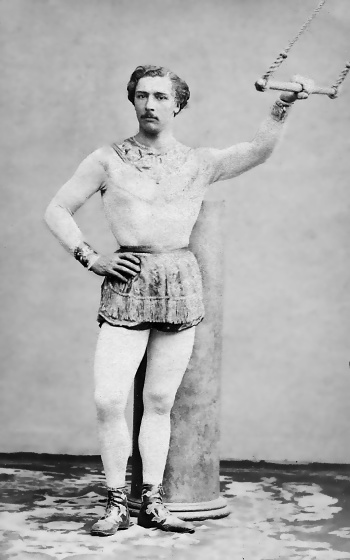
Men's underwear gets its superheroic connotations from the heroism of sports. Two-piece long johns are likely named after boxer John L Sullivan, the Irish-American heavyweight champion from 1881-92. Sullivan competed in long white leggings, as was customary in his sport at the time.
By 1925, boxers were wearing shorts held up by sashes or leather belts; but boxing equipment impresario Jacob Golomb, whose New York company Everlast had begun in 1910 as a maker of durable swimwear, had the bright idea of making the shorts elastic-waisted instead.
The design became popular as underpants, especially after WWII, where they had been standard issue underwear. Quite apart from the loose, airy sensation they offer – "there's nothing like running upstairs in silk boxers!" my friend Keith once swore – perhaps boxer shorts' original appeal lay in the possibility of feeling tough and strong like a pugilist or a soldier, but keeping this toughness hidden under one's clothes like Clark Kent, who made his DC Comics debut in 1938.

An image from Syd Miller's original Chesty Bond cartoon strip.
Australia's very own comic-strip superhero was Chesty Bond, who first pulled on his iconic singlet in 1940 to battle Hitler, Hirohito, enemy submarines, planes and spies. By 1942 he was appearing in Sydney's Sun five days a week. Cartoonist Syd Miller later told the Sydney Morning Herald that he'd envisioned Chesty as "an Australian strong man in deed and made super by or when he was wearing his Bonds singlet."
Chesty's famous lantern jaw was modelled on former NSW premier Jack Lang. Rugby league player and pro wrestler Max Whitehead modelled as Chesty from 1951, although he had to wear a prosthetic chin as nobody – with the possible exception of TV's Bondi Vet, Dr Chris Brown – looks like Chesty in real life.

Chris Brown: Chesty Bondi?
Superman also battled WWII-era villains in his trademark red briefs. Comic-book superheroes' outfits were modelled on the costumes of circus strongmen and acrobats; Jules Léotard, the French aerialist who first wowed London crowds in 1861, famously wore knitted tights to show off his athletic body and avoid getting tangled in trapezes. The contrasting-coloured trunks worn over the tights offered a degree of modesty as well as crotch support.

Hubba hubba: Jules Léotard.
Y-front briefs were innovated by Arthur Kneibler, who worked in sales and marketing for Michigan-based Cooper's Underwear. In 1934, when sleeveless, short-legged union suits already resembled swimwear, Kneibler received a postcard from the French Riviera depicting a very brief, topless bathing costume.
His version: snug-fitting underpants with no legs at all, and an overlapping front fly offering so much crotch support it resembled athletes' jockstraps‚ which themselves had been patented in 1874 for 'bicycle jockeys'. Hence Cooper's new brand name: Jockey.
'Tighty-whities' were so popular in the mid-20th century that they still hold that era's associations with clean-cut conservatism and hidden sexual perversity. A young Tom Cruise in Risky Business created an iconic image when he danced in his shirt, socks and underpants to Bob Seger's 'Old Time Rock'n'Roll'. As in many 1980s teen sex comedies, Cruise's undies signal dorky sexual inexperience.
Kevin Bacon wears them in the film National Lampoon's Animal House, set in 1962, as he's spanked with a paddle during a hazing ritual for an uptight college fraternity. "Thank you sir, may I have another?" he squawks absurdly between each stroke. Playing a conservative 1980s Los Angeles mayor in Rock of Ages, Bryan Cranston also gets paddled in his undies.

Cranston had already donned tighty-whities in a much-circulated publicity image from TV series Breaking Bad, in which he plays a mild-mannered chemistry teacher-turned-increasingly ruthless drug dealer. It's appropriate that 'breaking bad' means letting loose and challenging conventions, because more recently, pop culture depicts Y-fronts as undies for feckless slobs. Russell Brand wore them in Arthur, as did Will Ferrell in Talladega Nights; Jack Black has made them a signature garment.
However, pop culture still thinks of skimpy briefs as 'European', even more so now that boxer briefs have become a popular choice for men. Bikini briefs are associated with sleazebags and strutting Casanovas, especially in bright colours and animal prints. The Wedding Singer's oily villain Glen Guglia wears a leopard-print pair; Kazakh caricature Borat cheerfully dons a lime-green mankini.

Niiiiiice.
1 comment:
I'd suggest that the return to popularity of the "tighty-whitey" styled y-fronts that I've noticed is a reaction to the "metrosexual" phase, and a desire to return to the more masculine leanings of, say, characters in Mad Men. Plus, just as women's underwear has gotten incredibly expensive, so has men's underwear - particularly the boxer brief style that is so commonly manufactured by the likes of Bonds and so on, which may have also fuelled the current return of the old-fashioned y style.
Post a Comment